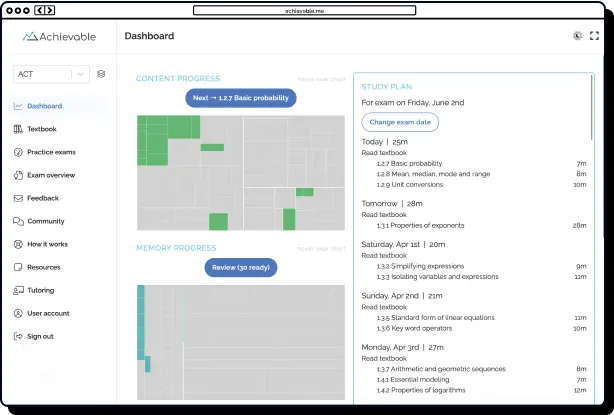
How do school tests differ from the SAT/ACT?




Table of contents
- School tests vs. ACT / SAT: Different goals, different tests
- Why is it harder to improve SAT and ACT scores than school test scores?
- Knowledge and concept-based vs. knowledge, concept, and skill-based
- How is the SAT Math section different from school math tests?
- Example school math questions
- How is the SAT Reading and Writing section different from school English tests?
- Become a better test taker
- Before the test:
- On the day of the test:
- Conclusion
This post was written in collaboration with Annie Tadros, Director, My College Prep Online
For students and parents, expectations about performing well on standardized tests like the ACT and SAT are often shaped by a student’s success on regular school exams. While strong academic skills and solid school test performance contribute to readiness, many are surprised by how unique the experience of taking admissions tests can be. Differences in structure and the specific skills assessed often make standardized tests much more challenging to master compared to typical classroom exams. Many find it frustrating that boosting their scores on the SAT or ACT requires different strategies than improving grades on standard school tests.
Understanding why these differences exist is crucial for effective test preparation. In this article, we’ll break down what sets standardized admissions exams apart from school exams and explore how the SAT and each of the ACT sections are designed to measure your abilities. Read on for actionable tips to help you adapt your test-taking approach to achieve higher scores.
This post was created in collaboration with Annie Tadros, Director of My College Prep Online.

School tests vs. ACT / SAT: Different goals, different tests
To understand the difference between school tests and standardized assessments such as the SAT and ACT, it’s important to look closely at how each test is structured and what skills they measure.
In school, each chapter test, midterm, or quiz serves as a step forward on your educational path. School tests focus on narrow topics, often centered around specific chapters or concepts you’ve recently studied. Questions are based on classroom discussions and assignments, with a heavy emphasis on memorization and straightforward recall. These exams stick rigidly to what has been taught, avoiding new concepts or unexpected material.
When it comes to standardized tests like the ACT and SAT, the experience is quite different. Unlike school exams, standardized assessments challenge you to apply knowledge learned over the last four years of your academic journey, or even further back when it comes to foundational math and grammar. Not only do these tests draw on a wide range of subjects, but they also introduce unfamiliar scenarios and ask you to reason through new problems independently. You’ll often need advanced analytical thinking, logical deduction, and problem-solving skills: the very tools required to interpret the more complex questions found throughout different ACT sections.
Standardized exams such as the ACT and SAT evaluate not only what information you can recall, but also your ability to apply, synthesize, and communicate that knowledge clearly. Each section demands a unique set of skills, making preparation much more comprehensive compared to traditional school tests. In other words, these exams measure how effectively you think through problems, solve unfamiliar questions, and express your ideas. To prepare for success on each of the ACT sections, students must move beyond memorization. Instead of simply knowing rules or formulas, you’ll need a deep understanding and the ability to apply concepts flexibly under different circumstances, choosing the right strategies for each task you face.
Why is it harder to improve SAT and ACT scores than school test scores?
Score increases on school tests are typically linear, which directly impacts how to improve ACT or SAT scores compared to classroom exams. In school assessments, each question generally tests a single concept or segment, so your score reflects the percentage of questions answered correctly. For example, earning a 95 on a school test means you correctly solved 95% of the questions. To improve your score in this setting, you simply identify the specific skills, facts, formulas, or rules you missed, focus on those areas, and get more questions right next time. This strategy leads to a straightforward path for score improvement.
However, understanding how to improve scores requires a different approach because progress on standardized exams like the SAT or ACT is not always linear. While answering more questions correctly will raise your score, these exams often feature questions that assess multiple concepts or skills within a single problem. This means that to boost your SAT or ACT score, you must master and integrate several concepts at once to solve challenging questions you previously missed. The relationship between what you’ve learned and your SAT score can vary significantly from question to question, making the process of improving your standardized test scores more complex than simply learning one new fact per question.
This difference is a key reason why students sometimes feel frustrated when trying to figure out how to improve their test scores efficiently. In school, there is typically a direct and predictable link between learning and higher scores. On standardized tests like the SAT and ACT, this connection may be less obvious: students often need to learn and apply multiple concepts simultaneously to see a noticeable increase in their test scores. Understanding this distinction is crucial for developing effective strategies to improve SAT performance and overcome common challenges faced by test-takers.

Knowledge and concept-based vs. knowledge, concept, and skill-based
School exams are predictable, as questions closely resemble classwork and homework assignments. These exams usually focus on measuring your ability to recall facts, rules, and formulas learned in class.
Standardized tests, such as the SAT and ACT, however, introduce a new level of complexity. These assessments blend knowledge, understanding, and skill, challenging you not only on what you’ve learned but also on how you apply your knowledge in unfamiliar situations. Standardized tests are designed to evaluate critical thinking and problem-solving skills, setting them apart from traditional school exams.
Consider the SAT Reading and Writing sections. Unlike straightforward textbook excerpts, SAT Reading passages feature complex structures, intricate relationships between the author and their argument, and subtle cues that require deeper analysis. Reading comprehension questions are crafted to assess your ability to interpret the author’s intentions, draw inferences from nuanced details, and synthesize information across multiple paragraphs. Success in SAT Reading is not just about recognizing vocabulary or spotting literary devices; it’s about deeply engaging with each passage, breaking down its layers of meaning, and extracting key insights.
Similarly, grammar and math questions on standardized tests demand more than rote recall. While a solid foundation of rules is essential, the emphasis shifts to applying those rules to solve new and challenging problems. Whether you’re tackling the SAT or ACT, standardized tests measure how you think and how effectively you use your knowledge, not just what you remember.
How is the SAT Math section different from school math tests?
The SAT Math section covers the same core mathematical concepts found in typical school math tests; however, SAT Math questions are presented in unique ways that test a deeper understanding of these concepts. Unlike standard classroom exams that emphasize memorization and formula recall, the SAT Math section focuses on critical thinking, advanced problem-solving, and applying mathematical reasoning to unfamiliar scenarios.
In SAT Math, questions rarely involve simply plugging numbers into formulas. Instead, SAT Math problems often blend multiple topics, such as algebra, geometry, or data analysis, requiring you to connect concepts and apply your math skills creatively and strategically. This approach challenges you to use logical reasoning and draw from a broad knowledge base to solve complex problems.
For example, a single SAT Math question might integrate elements of both algebra and geometry, asking you to analyze relationships between variables, equations, and geometric figures. This combination of concepts pushes you to evaluate different strategies before selecting the most efficient path to the solution.
Consider the following SAT Math example: a formula is provided for calculating the monthly payment required to pay off a loan, taking into account interest rates and loan duration. The answer choices may present various expressions for the principal loan amount § in terms of the monthly payment (m), interest rate (r), and number of months (N). This formula requires dividing by a term with an exponent, testing your grasp of exponents and the order of operations.

To solve this problem, you must isolate the unknown variable, which in this case is m (the monthly payment). Successfully manipulating the equation to solve for m demonstrates your ability to apply mathematical concepts under test conditions, a key skill for excelling on the SAT Math section.
These kinds of integrated, multi-step problems make SAT Math more challenging for some students, especially those who are less comfortable with complex formulas or multiple-step reasoning. Mastering these skills is crucial for achieving a high score on the SAT Math section.
Example school math questions
As you can see from the examples below, math questions on school tests tend to be more straightforward, testing students on a single concept at a time instead of multiple concepts simultaneously.
Isolating Variables

Dividing Fractions

Exponents

How is the SAT Reading and Writing section different from school English tests?
SAT and ACT questions covering reading, writing, and language skills often mirror the structure of SAT Math problems, challenging students to apply their knowledge in new ways. While literature exams in school may focus on familiar texts, such as analyzing Shakespeare or exploring symbolism, the SAT Reading and ACT sections take it a step further by presenting passages on a range of unfamiliar topics. Each passage is designed to test your ability to quickly analyze and interpret information, an essential skill for boosting SAT scores. Both reading comprehension and grammar remain central, but the SAT Reading section emphasizes deeper analysis, demanding that you break down arguments and evidence rather than just summarize content. Mastering these advanced strategies is key to tackling the unique challenges found in each SAT and ACT section.
Become a better test taker
Standardized tests can be intimidating, but there are strategies you can use to become a better and more confident test taker. Being “good at taking tests” means striking a balance between getting questions right and going through the test efficiently. Remember that you’ll only have anywhere between 30 seconds and about a minute per question on the SAT or ACT, so speed is as important as aptitude.
With practice, you can improve your test scores and the time it takes to complete assessments. The steps below will help guide your SAT and ACT prep, and will also give you valuable insight on how to smartly approach any and all future exams.
Before the test:
- Be comfortable with the exam material. Stay on top of your studies and identify areas you struggle with early. Take the time to understand difficult concepts and review them with a teacher or tutor if necessary.
- Having a strong base of knowledge from your English, math, and science classes will make it easier to tackle the same concepts on the SAT or ACT.
- Create a study guide. List key concepts and create a plan to cover each one as needed. For exams like the ACT and the SAT, ensure your study guide covers each section and topic included on the exam.
- Train yourself with practice questions. Mastering exams is like learning a new skill: practice makes perfect. Answer mock questions modeled after the actual exam and pay attention to any weak spots.
- Use techniques tailored to each kind of question: for example, there are countless math tricks that make solving complex problems more intuitive (and faster).
- Focus on comprehension to better retain the information. Knowing the why behind a correct answer will make it easier to solve similar problems in the future.
- Take full-length practice exams. Use practice tests to familiarize yourself with the exam format and gauge your performance as you study.
- While this may not always be possible with school exams, numerous test prep resources offer realistic practice tests for standardized assessments. Time yourself to simulate the real conditions of the official test day.
- Use study aids effectively. Flashcards are great for active recall, but successful studying involves more than just memorization. Pair things like flashcards with more robust study tools, such as practice questions and reading materials.
- Study with a friend or group. Studying with other people can help provide support and accountability.
On the day of the test:
- Develop a healthy test day routine. Get plenty of rest the night before, eat a good breakfast, and stay calm and confident.
- Read every question carefully. Test questions can be worded ambiguously. Remember that exams assess your knowledge and your ability to think critically about what each question is really asking.
- Show your work. Writing out your approach, even if it’s not required, allows you to answer questions thoughtfully and review your work more easily. For fully digital exams like the SAT, it’s still a good idea to have scratch paper for jotting down notes and solutions.
- Use the “skip” technique to your advantage. This tip is especially important for admissions exams. If you’re finding that one question is stumping you, move on to the next one to avoid spending too much time on one problem.
- Not answering one question is better than missing several others. You can always go back to that question if there’s time.
- Double-check your work. At the end of your test, save time reviewing your answers and making any last-minute fixes.
- Don’t cram. You’re not going to learn everything the night before, and trying to do so will only cause stress on the test day. Plan your study schedule in advance. You may need only a few days of review for a school exam, but admissions tests can require months of preparation.

Conclusion
The bottom line is this: achieving strong results on standardized tests like the SAT and ACT calls for a distinct set of strategies compared to traditional school exams. Recognizing the unique demands of standardized tests is essential when figuring out how to improve SAT scores, especially if high-achieving students aren’t seeing the progress they expect. By moving beyond memorizing facts and focusing on applying underlying concepts in unfamiliar contexts, you’ll be positioned to make meaningful gains on standardized test scores and develop effective test-taking skills.

